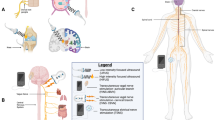Abstract
A broad overview of invasive and noninvasive neuromodulatory methods presented in this book has demonstrated that neuromodulation is a rapidly growing field of expertise with enormous potential for research and therapy. However, existing studies and clinical observations show enormous heterogeneity in protocols, dosages, and devices, as well as in documentation and reporting results or complications, making comparisons across studies or patient populations difficult. For most of the existing neuromodulatory methods, durability of the effects as well as factors contributing to the variability in the treatment outcomes have yet to be determined. Further research is needed to fill gaps in understanding neurophysiological mechanisms underlying the effects of specific neuromodulatory approaches, and large-sample clinical trials are needed for those neuromodulatory methods that indicated analgesic efficacy in pilot studies. Further, the future use of neuromodulation would benefit from the development of patient-tailored treatment regimens supported by imaging-assisted diagnostic assessment.
Access provided by Autonomous University of Puebla. Download chapter PDF
Similar content being viewed by others
Keywords
- Conclusive Overview
- Neuromodulation Methods
- Neuromodulatory Approaches
- Large-sample Clinical Trials
- Analgesic Efficacy
These keywords were added by machine and not by the authors. This process is experimental and the keywords may be updated as the learning algorithm improves.
In this textbook, experts in the field of neuromodulation from all over the world presented an overview of invasive and noninvasive neuromodulatory approaches and its potential for the treatment of various pathological states and conditions.
The book can serve as a structured guide for clinicians, scientific researchers, medical staffs, and students to get an insight, structured overview, as well as specific clinically relevant information about the neuromodulation techniques. Every chapter strived to provide up-to-date information regarding underlying physiological mechanisms, technical aspects, and application protocols in the scope of good clinical practice and safe performance of these methods and procedures. All chapters have an extensive reference list that can serve as an additional source for those interested in more extensive and in-depth information.
The broad overview of invasive and noninvasive neuromodulatory methods presented in this book has indeed demonstrated that neuromodulation is a rapidly growing field of expertise with enormous potential for research and therapy. Although some invasive procedures are performed for more than 30 years, e.g., deep brain stimulation, a revival is witnessed during the past 10 years because of new experimental research, medical experience, controlled trials with new indications, and ongoing technological improvement. Building on the foundations of available up-to-date evidence, each neuromodulatory method can benefit from further technical progress, continuing development, and targeted clinical applications. In specific,
-
Existing studies and clinical observations show enormous heterogeneity of protocols, dosages, and devices and therefore results from the studies are difficult to compare and/or reproduce.
-
The documentation and reporting of adverse events or negative results in published literature on neuromodulation highly vary, making it difficult to evaluate the methods across the treatment protocols and patient populations.
-
Further research is needed to fill gaps in understanding neurophysiological mechanisms underlying the effects of specific neuromodulatory methods. Traditional neurophysiological approaches together with novel disciplines, such as epigenetics, can greatly contribute to this endeavor.
-
Large-sample Phase III clinical trials are needed for those neuromodulatory methods that indicated analgesic efficacy in pilot and Phase II clinical studies.
-
For methods that have not yet been fully implemented into clinical practice, more evidence is needed not only on efficacy, but also on safety and cost-effectiveness in clinical settings.
-
For most of the existing neuromodulatory methods, approaches, and protocols, durability of the effects as well as factors contributing to the treatment responsiveness have yet to be established and need to be evaluated in long-term follow-up.
-
Consequently, an effective and patient-friendly use of neuromodulation calls for the dose adjustments for specific populations (for example children), with the ultimate goal of the development of patient-tailored treatment regimens supported by imaging-assisted diagnostic assessment prior to the neuromodulatory procedures.
-
Further, technical refinement of neuromodulatory devices and procedures, including miniaturization of electronic devices, further implementation of biotechnologies, robotics, or nanotechnology, can facilitate user-friendly modifications of neuromodulatory devices, general safety, reduction in the complication rate of the invasive neuromodulatory procedures, and availability of novel research and treatment protocols.
-
Regarding education in the field of neuromodulation, more educational initiatives are needed on all fronts of the field, from educational materials for patients to comprehensive educational and training programs for providers, and topic-relevant education for supporting medical and research personnel. A full integration of neuromodulation into international and national medical education programs needs to be facilitated and supported by all involved disciplines and societies.
Overall, it can be expected that the future initiatives in the field of neuromodulation will encompass developing novel neuromodulatory approaches, methods, devices, and treatment protocols; facilitating basic and clinical research; building evidence base on safety, efficacy, and effectiveness; implementation of neuromodulatory treatment approaches into clinical practice when appropriate; developing and periodically reviewing/updating guidelines for the use of specific neuromodulatory methods; implementing and facilitating educational and/or training programs for both providers and recipients of the neuromodulatory procedures; as well as other activities that will contribute to the overall development of this exciting field of expertise.
Author information
Authors and Affiliations
Corresponding author
Editor information
Editors and Affiliations
Rights and permissions
Copyright information
© 2015 Springer Science+Business Media, LLC
About this chapter
Cite this chapter
Rasche, D., Knotkova, H. (2015). Conclusive Overview. In: Knotkova, H., Rasche, D. (eds) Textbook of Neuromodulation. Springer, New York, NY. https://doi.org/10.1007/978-1-4939-1408-1_19
Download citation
DOI: https://doi.org/10.1007/978-1-4939-1408-1_19
Published:
Publisher Name: Springer, New York, NY
Print ISBN: 978-1-4939-1407-4
Online ISBN: 978-1-4939-1408-1
eBook Packages: MedicineMedicine (R0)




